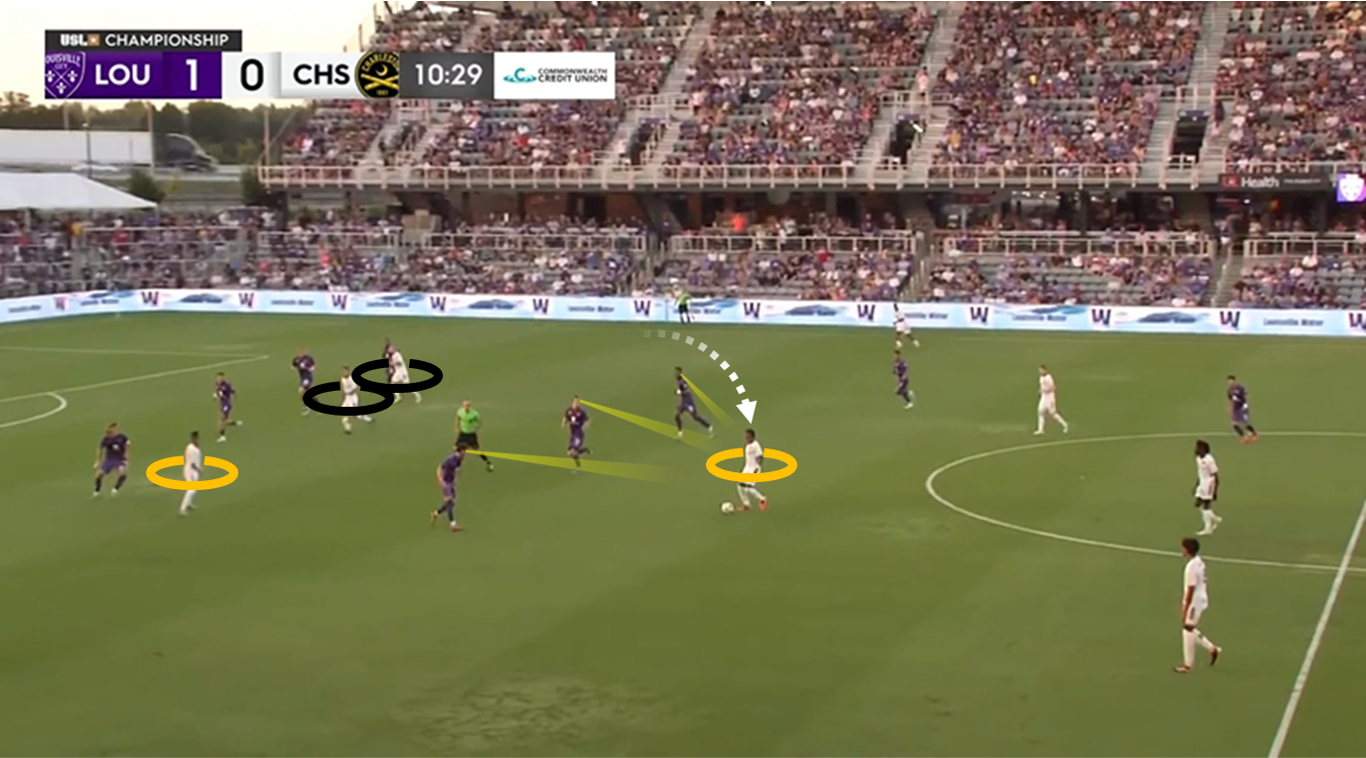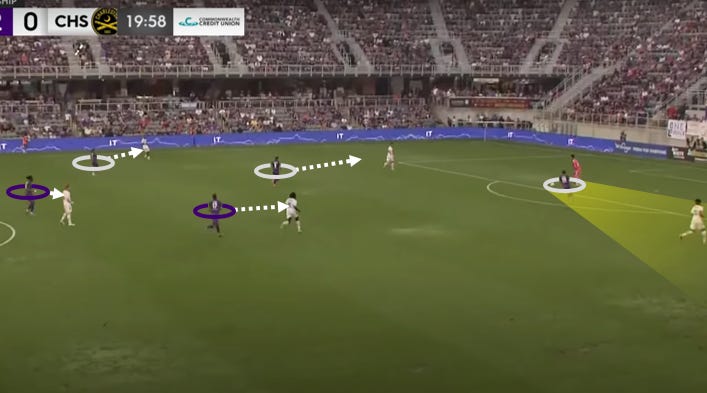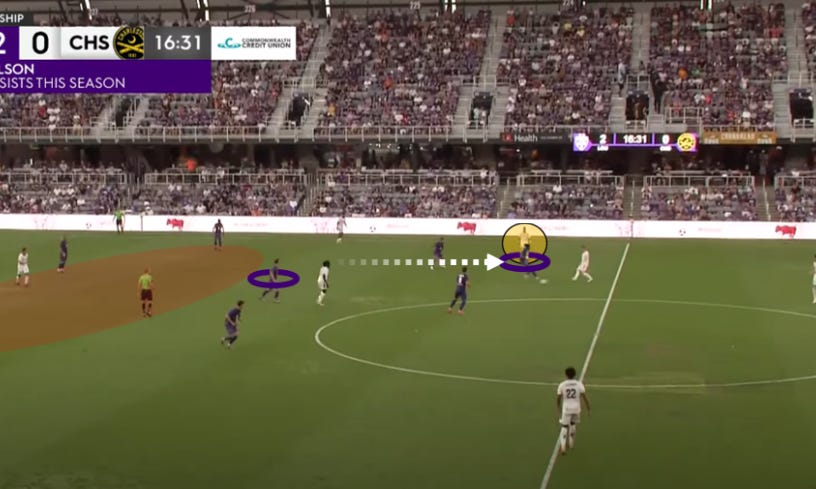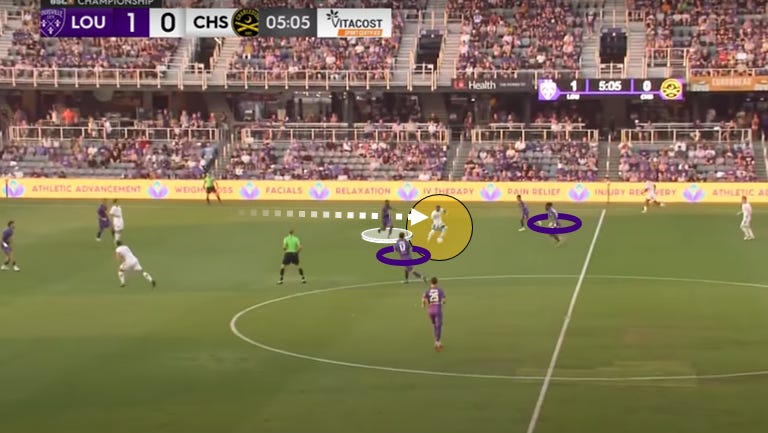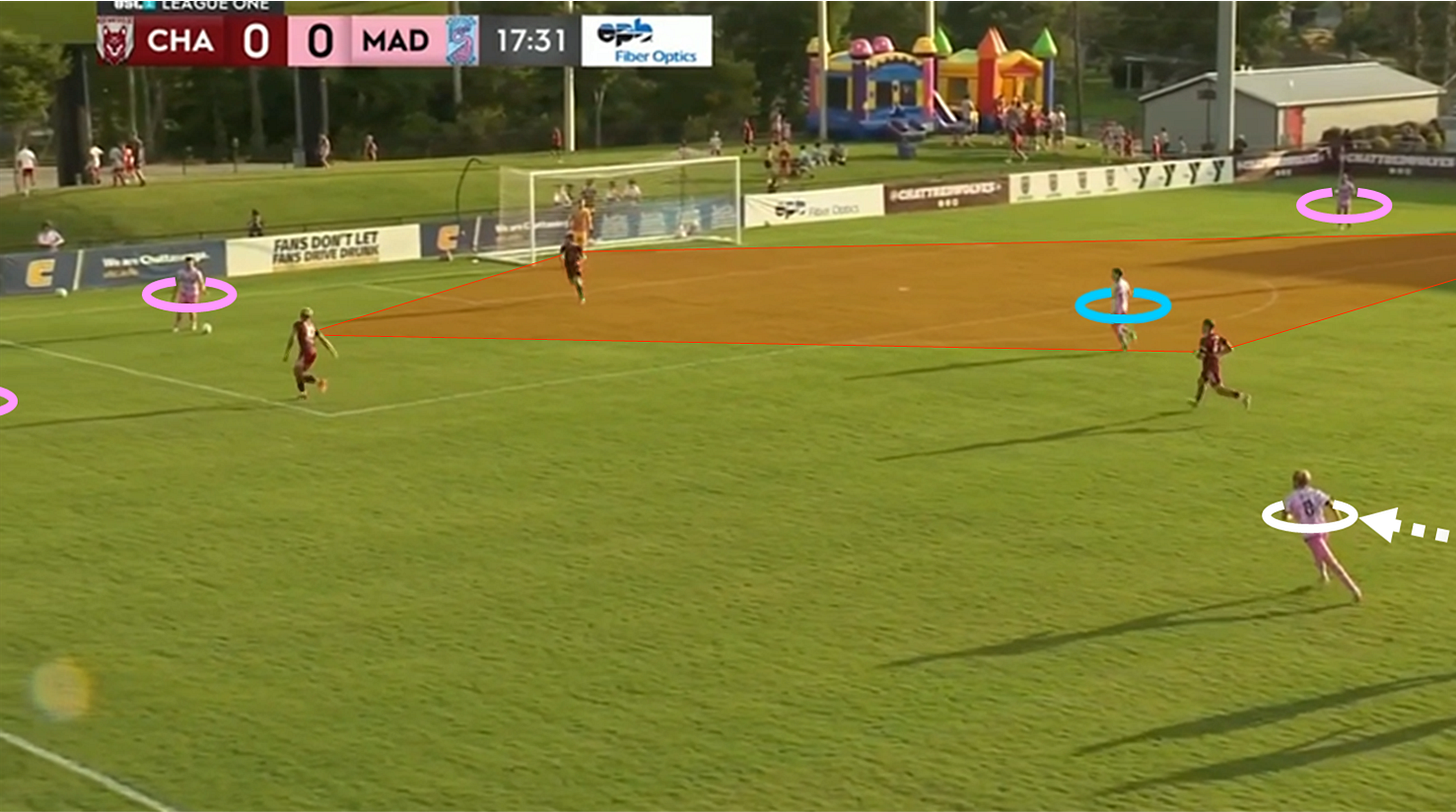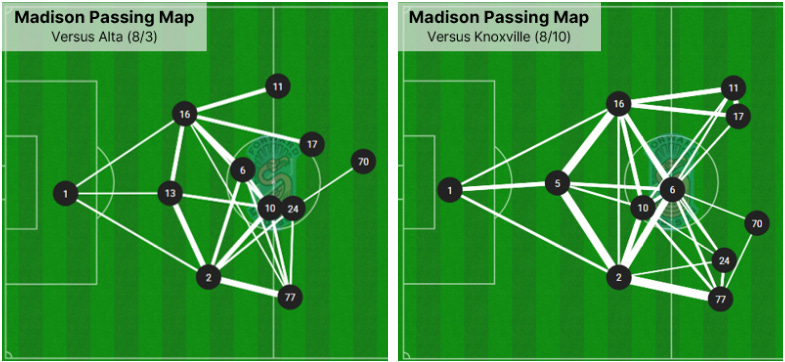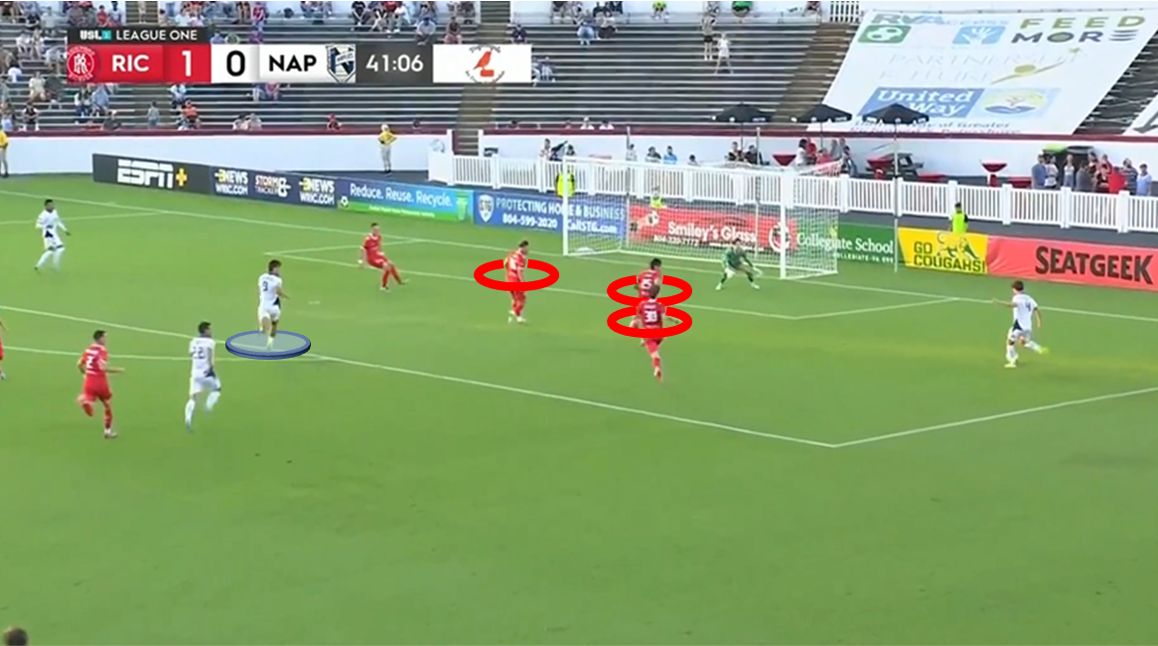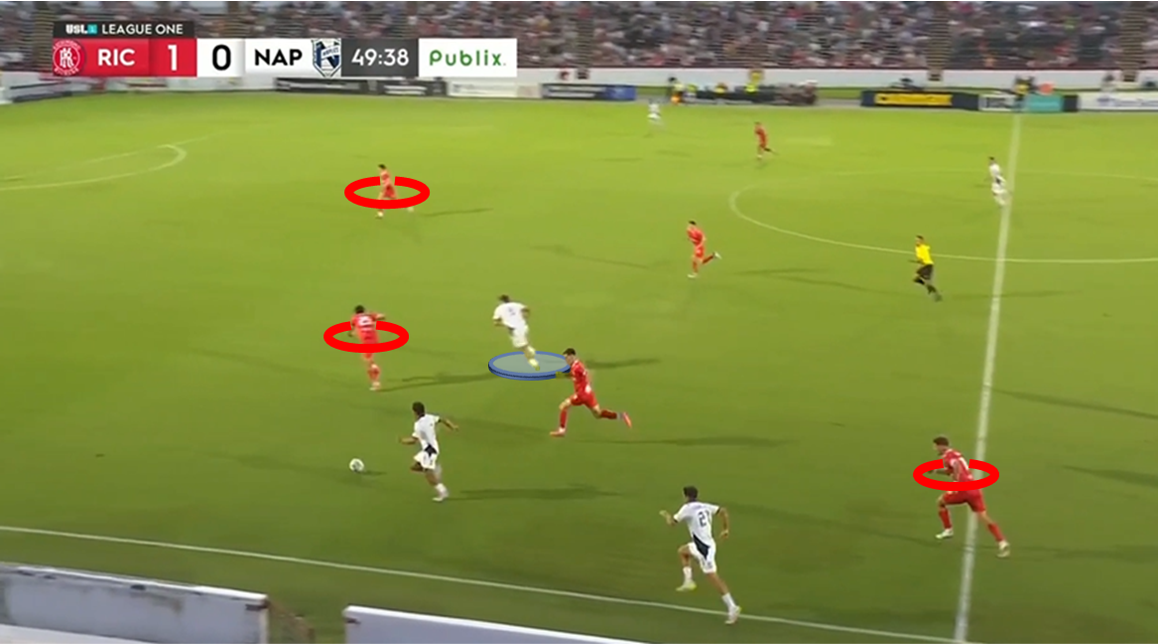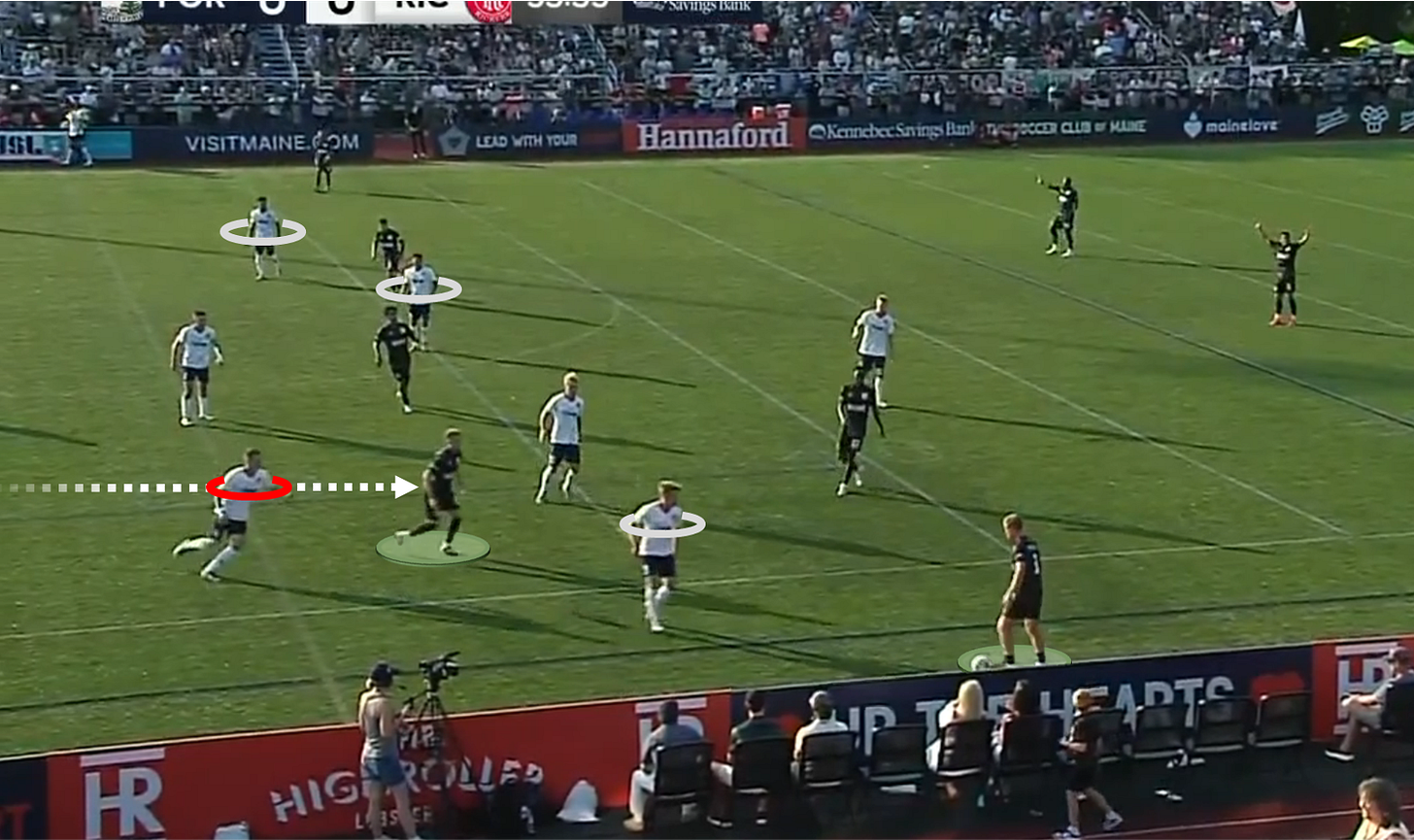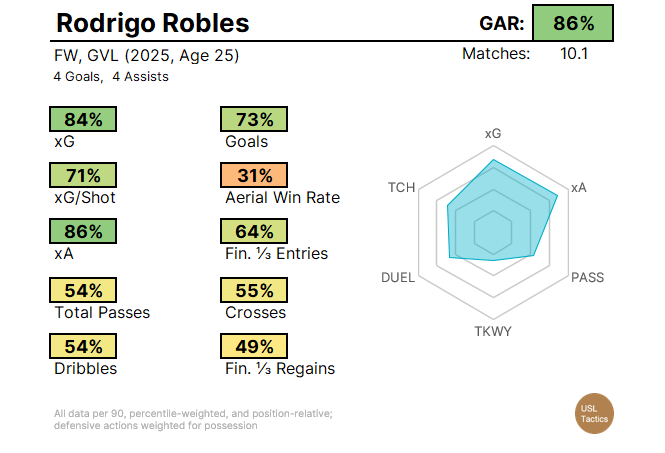Welcome in to The Back Four!
Before we start, check out Backheeled for Charles Ahl love, Sacramento’s midfield dominance, and more. You can also find This League! on the site for an audiovisual dive into the week that was.
Without further ado, let’s get to it.
Louisville’s perfect press
We’ll get into Louisville’s dominance momentarily, but I want to start with a classic Charleston moment – the sort of situation the Battery try to create in possession.
Below, you’re seeing winger Juan David Torres tuck inside and receive in front of the midfield, drawing three players his way in the process. Ahead of him within Charleston’s 4-2-2-2ish shape, three players (MD Myers, Cal Jennings, narrow Arturo Rodriguez) make themselves available.
As we’ll see, this sort of situation…
…was exceedingly rare in a match where Louisville City routed their top-of-the East rivals. Torres took just three touches in zone 14 before subbing off at halftime, at which point the Battery were already trailing by four goals. Torres, Myers, and Jennings only connected on six passes between one another all night long.
Louisville’s 5-2-3 press shut down all the patterns that usually furnish Charleston with dominant results, constantly painting them into corners. By the time the match hit that four-goal margin, the Battery had put just 0.31 xG on frame.
What made it happen? In the high press, Jansen Wilson and Ray Serrano had a terrific sense of when to close down and how to arc their angles to limit the Battery’s options. Phillip Goodrum (six defensive actions, 13 duels) sat between them and brought a selfless, energetic character that held the defense together.
You see those relationships playing out here. Goalkeeper Luis Zamudio has the ball, and Wilson curls toward him from the right wing to make sure Charleston can only go right. Every member of the Louisville press reacts in kind.
Across the rest of the grey-coded front line, Goodrum and Serrano address potential receivers. No matter who Zamudio might want to target with a short pass, that player is going to be closed down in a matter of moments.
Likewise, Taylor Davila and Kevin Lambert pick up marks between the lines. If Charleston tries a quick pass into the pivot to establish rhythm, it won’t be easy; any reception up the middle will be met with immediate backpressure.
The marking scheme didn’t show up in the box score – Lambert didn’t attempt a single tackle! – but the high-low relationship between the two center mids was absolutely definitional in practice. Both Louisville’s second and third goals came in similar situations with Charleston forced to squeeze through a titled press. Each instance featured Lambert disrupting passing lanes and Davila recovering the ball before starting a counter.
Even in a mid-block 5-4-1 posture – a meaningful distinction against the hinged-wing high press – Louisville understood how they could use ball pressure to bend Charleston to their will.
This play, six minutes after the Torres touch we started with, is far better for Danny Cruz and company. In fact, Torres (circled) is one of his side’s deepest-seated players, dropping below the level of the fullbacks to seek out the ball.
Lambert and Davila’s spacing is key once more. Time and again, the Jamaican international pushed ahead like a bulldozer, preventing Charleston from hitting their No. 6s on the turn Lambert doesn’t just charge at the ball here; he does so at an angle that prevents a sideways pass to Torres.
Davila, meanwhile, sits deeper and shadows the pocket of space between lines. You can actually see MD Myers sniffing out that gap, but Davila makes the window impossibly tight while still providing face-up pressure against Houssou Landry at the No. 6 spot.
Same idea here, albeit with the pivot beaten. This time, it’s Amadou Dia flying ahead from left wingback to put pressure on the ball. That close-down will slow the receiver, allow Lambert to get back, encourage a backwards pass, and stymie Charleston. The success relies on more than just Dia; you can already see Serrano sneaking back to fill low on the left side.
There were, of course, exceptions. A minute into the game, Cal Jennings got a chance when Arturo Ordonez overstepped and missed a tackle. Targeted balls into the right channel that forced Ordonez into rotation were consistently threatening.
Still, Danny Cruz rightly accepted that risk. Ordonez’s disruption denied the spaces behind the front end of the press, assuring that Myers would attempt just two forward passes and that Jennings would get only two touches in zone 14. Josh Jones and Kyle Adams did splendidly to fill behind Ordonez when he stepped up. At every level, the layers of LouCity’s 5-2-3 came good.
What more can you say? This defense is immaculate. Without a doubt, Louisville has planted their flag as the team to beat in the USL.
Madison’s Villalobos-sized hole
In all of Forward Madison’s most important matches last year – playoffs, Jagermeister Cup knockouts, final days of the regular season – it was Jimmie Villalobos starting next to John Murphy in the pivot. When those two started together last year, Madison allowed just 0.8 goals per 90. Those minutes resulted in 14% more shots and 20% less crosses than with any other starting combo – collectively representing a more solid shape with a better ability to attack up the middle.
Recent results underpin how this club is (or isn’t adapting) as 2025 nears its climax. While Forward Madison dominated a recent game against AV Alta, allowing just 0.26 xG while conceding 63% possession, the visitors’ rare moments of joy came because of a dearth of protection through the midfield. The same could be said of a vastly more physical and direct duel against Chattanooga last Wednesday.
The new mix isn’t necessarily bad – it’s just different. Madison is altering the relationship between the center backs and pivot in their 3-4-3 and improving because of it.
Consider the Alta match, where loanee Temi Ereku had a genuinely great outing as the centermost defender in the back three. Used as a No. 6 in his rare appearances for Birmingham, Ereku fit like a glove in Madison’s defense in a match where active interventionism was the order of the day.
Ereku was primarily charged with marking opposing striker Emmanuel Alaribe, the type of forward wont to drift all over the pitch. Alaribe ended up with just 17 touches – his lowest count in any start all season – yet still managed to do damage when Ereku and the pivot lost their alignment.
The chance clipped above was Antelope Valley’s highest-xG opportunity, and it began with a missed tackle against Alaribe. In this sort of transitional moment, you’d love to see a classic No. 6 in position to sweep up danger, even if this play is a post-set piece transition. That doesn’t happen. Instead, Ereku has to give chase and cedes acres of spaces when his challenge misses.
You’ll note that it’s none other than Villalobos connecting with Alaribe to break through. While the chance ultimately goes wanting, it’s evidential of (1) Madison’s occasional between-the-lines gaps necessitating defensive overreactions and (2) the central spark that’s been lost in the post-Villalobos era. In fact, none of this team’s center mids have more than eight key passes this year.
Even in traditional run-of-play moments, similar dilemmas have shone through. Consider the example above, where Madison builds out from the back versus Chattanooga’s rabid 3-4-3 press. In this case, Murphy is all alone at the base of Madison’s matching formation, with pivot partner Isaac Angking having stepped upfield.
It’s a lethal choice. The Red Wolves close down on goalkeeper Wallis Lapsley, force a panic, and use their angles to deny a pass into Murphy. You see Devin Boyce (in white) showing into the midfield to try to make up the difference, but it’s so obviously a situation where a premier table-setting No. 6 like Villalobos – a master at bending presses with his movement – is missed.
This play ultimately leads to a turnover and a chance in the box for Chattanooga, wrought of lacking alignment on the edge of the 18-yard area. Meanwhile, the Red Wolves regularly played over Madison’s 5-4-1 and dominated second-ball situations; the Red Wolves’ 54th minute go-ahead goal came with Murphy and Angking beginning to push upfield too eagerly after a regain, thereby allowing for a through ball to tear the defense asunder.
Saturday’s draw against Knoxville was much better, even if you allow for the difference in style as compared to Chattanooga. Madison was quicker playing out of the back, more vertical, and understood how to balance the responsibilities of their midfielders.
On Wednesday, Jake Crull and Michael Chilaka went long on just 8% of their attempts, too often playing sideways and baiting the press. On Saturday, by contrast, that number leapt to 13% in a match where Madison put up 2.2 xG. Their leading final-third passers were:
Jake Crull (16 entry passes)
Nico Brown (16)
Michael Chilaka (15)
John Murphy (13)
Derek Gebhard (11)
…
T-10. Angking & Mesias (5)
I highlight those numbers to praise Madison’s approach. Rather than fit a square roster into a round tactical hole, Matt Glaeser emphasized half-space connections and allowed his midfield to focus on rest defending against a strong Knoxville break.
Compare the Madison pass maps between the Alta and Knoxville games, and you’ll note that the wingbacks and wingers were able to take up far more aggressive positions. The formation often approximated a 3-2-5, a shape in which Mesias and Murphy could sit safely in the pivot and focus on that aforementioned rest defensive surety.
The center mid corps combined to contest 17 duels, proving effective at stopping opposing breaks. Murphy was still allowed to be aggressive in the press if Knoxville built short, belying the deeper-seated possessive position with strong man marking. Both he and Mesias did well to keep pressure on the backs of Knoxville’s Angelo Kelly (zero chances created on 61 touches, six final-third entries versus a season average of 8.2 entering the weekend) and the ball-side winger.
Less good? The fact that Knoxville’s two worst xG allowances, chances conceded in the 2nd and 72nd minutes, came off errant passes into the central midfield that led to opposing fast breaks. In each case, Madison got too cute: they dropped numbers low, committed to short passing against One Knox’s stout press, and suffered for it.
Madison mostly skirted those issues by working around the edges, and that mode feels like the only way forward for Madison. There’s still room for momentary expressiveness – think about the high press or Murphy’s trademark late arrivals to the edge of the area – but unless a hyper-athletic center back emerges, we need to see Madison’s No. 8s continue to reshape their roles.
Nick Firmino, good at soccer
Lexington is still beneath the playoff line, but this weekend’s win against Phoenix went a long way in changing that fact. Rising represent Lexington’s nearest rival in the hunt for the eighth seed, and they got picked apart on Saturday because of fluid midfield play led by none other than Nick Firmino.
When Firmino signed for Lexington this winter, he was probably a familiar name for many USL fans because of his prior stints at Union Omaha in League One and Atlanta United 2 during their Championship years. While the 24-year-old has started for the majority of the season, he truly came into his own at the end of May.
At that point, Firmino dropped into the pivot in the place of Speedy Williams, immediately improving LSC’s sense of tempo and flow – at least according to the eye test. In some sense, the returns have been mixed. Across all USL competitions, Lexington averaged 1.28 xG per match in 11 games before the switch. That number has stayed flat at 1.25 xG a pop in 13 matches since. Likewise, LSC has maintained a 52% possession average in each period.
All of those numbers are meaningful, but final third entry statistics tell the full story. Firmino is a terrific mover without the ball, one that’s allowed Lexington to access the attacking zone with far greater ease and, therefore, tilt the pitch in an advantageous fashion. LSC enters the final third 24% more often when Firmino starts versus when he sits. The improved tilt has allowed Lexington to concede just 1.1 goals per game since the end of May, all while becoming a sharper side in possession.
What does that improvement look like in practice? Here, you’re seeing the midfielder operating out of the pivot during a Week 22 match against Colorado Springs. Lexington lost this game, but #8 completed 51 of his 52 pass attempts and hit on eight entries into the final third.
You get two examples of Firmino reading space here. In the first, Blaine Ferri – Firmino’s pivot partner – possesses at the base of the midfield and draws the eyelines of both of the Switchbacks’ most advanced pressers. By this point, Colorado Springs had switched from a 4-1-4-1 into a 4-2-3-1 shape, meaning that a high-low split between Ferri and Firmino could create a targeted overload against the opposing No. 10.
Here, Firmino smartly holds his run, knowing that it’ll be difficult for Ferri to bend a short pass, even on his stronger left foot. Once Ferri cuts back, Firmino shows hard into the center circle and receives with his momentum turning upfield. Moments later, he’ll hit Michael Adedokun on the left to enter the final third.
In the second play, Firmino is bending the opposing No. 10 yet again. Knowing that Joe Hafferty intends to cut inside on the dribble and go one-on-one, the former Atlanta United prospect decides to clear space to make it happen. To do so, Firmino underlaps Hafferty, driving upfield and drawing a marker with him.
The run essentially creates a basketball-style pick, running two defenders into one another. The result is open space for Hafferty and, shortly thereafter, a pass over the top. None of it is possible without Firmino’s off-ball movement at the start of the sequence.
This weekend, Firmino played as the right mid in Lexington’s off-ball 4-4-2 and the right-sided No. 10 in their possessive box-shaped midfield. On paper, the numbers were worse. Firmino only completed three final-third entry passes, yet the numbers don’t tell the whole story. As you see above, Firmino understood exactly how to manipulate the defense with his movement and let teammates take the spotlight.
Here, it’s Hafferty operating in the inside position with #8 selflessly taking up a spot at the sideline. That level of rotation between a defender and midfielder is exceedingly rare to see, but it maintains that box-midfield dynamic to open up a quick entry pass and flick-on that leads Firmino into the final third.
No matter where he’s positioned, Nick Firmino is constantly making these plays happen. If Lexington pushes on and makes the playoffs – and I wouldn’t bet against it, frankly – then it’ll be Firmino that leads the charge.
Reconnoitered Richmond
Richmond is stuck between a rock and a hard place. Last week, it was time to try a back three at City Stadium, but the Kickers couldn’t hold firm against FC Naples. This weekend, they ditched the true 3-5-2 in favor of a far more familiar shape – albeit one with some changes built in.
To understand the 4-2-4 that earned a draw away in Portland, we need to start with the problems seen against Naples. Richmond aggressively deployed their wingbacks to close down against the ball, relying on the outside members of the back three – Klaidi Cela and Griffin Garnett – to rotate and fill the vacated space behind said wingbacks. Finding that balance was a chore.
You get an example here that’s essentially taken in media res, with Garnett already beaten and the remaining two center backs filling space behind him. Wingback Maxi Schnenfeld isn’t even in the frame.
Closer to goal, the three center halves fail to communicate. Garnett inserts himself into no-man’s land as the trailing player; Cela and Marcelo Lage occupy the same horizontal plane merely feet from one another. An instant later, this’ll turn into a dangerous shot for opposing striker Karsen Henderlong.
Similar story here. Cela is played past, and while Dakota Barnathan knows to get low from the defensive midfield, the center backs are badly out of sync once more. Lage is charging at the ball-carrying Naples fullback, but that opens a seam for Henderlong to attack in behind. This play will ultimately end in a penalty concession for Richmond because of the disconnected rotations.
What’s clear is that a true back three didn’t suit Richmond’s personnel. Given how aggressive Simon Fitch and Maxi Schenfeld were allowed to get at wingback, the balance just wasn’t right.
Hence the return to a 4-2-4, albeit one that accommodated back five principles. I’m not saying that Richmond played an out-and-out 5-2-3 in block, but they trusted Hayden Anderson – a fullback at certain points during his rookie season with Greenville – to drop deep from the right wing and provide a steadying presence as required.
Consider the math in those moments. Instead of isolating three center backs without world-beating athleticism, the Kickers could leverage a more sprightly back four and buttress it with Anderson’s steadying presence. In the simplest terms, it’s “three” versus “five” – and it’s why Portland couldn’t even muster 0.7 xG this weekend.
Above, you’re seeing the flip side of that coin. Here, the right back is tracking Ollie Wright far into the attacking half, assuring that Portland’s best creator can’t just receive and charge at a flat-footed defense. It’s an aggressive move from Fitch, but compare it to the examples from the Naples game; Richmond is keeping the opposition in front of them!
This sort of situation was less risky because of the Fitch-Anderson symbiosis. The fullback gets beat? You’ve got a winger ready to track back.
Anderson ultimately put in three tackles and contested 12 duels. Fitch, meanwhile, only fought for three duels and didn’t even try a tackle. That’s not to indict Fitch, but it says a lot about their relationship.
The Kickers still have things to figure out, but the experimentation is good to see. Between improving defensive structures and the potential rise of Landon Johnson, Sawatzky is willing to pull levers to get results as 2025 hits its crescendo. With Richmond just four points back of the playoffs, there’s a real chance those tweaks prove to be the thing that brings postseason action back to City Stadium.
(“…back to City Stadium” in the synecdoche sense. This team ain’t getting a home playoff game.)
Quick Hits
In other news this week…
I tend to be pessimistic about new signings as a rule, but Kobe Hernandez-Foster is killing it in Detroit. I know Le Rouge played a man up for 60 minutes this weekend, but the former Birmingham man went 93 for 100 as a passer! That’s crazy! More importantly, Hernandez-Foster isn’t just passing sideways. He’s breaking lines, combining with teammates, and opening more space for Detroit in important areas.
To continue the Louisville discussion, shout out to Damian Las for a few point-blank saves in the opening minutes. He ended up allowing 0.23 goals above expectation, which is unduly harsh given the importance of those early stops.
Greenville’s 5-4 win over Charlotte rocked, and I’m here to tell you that the Triumph’s 4-4-2 is deadly. That setup allowed Chevone Marsh to eat up in the seams between Independence defenders, largely due to Ropapa Mensah’s hold-up-and-spray play with his back to goal and the ingenuity of Rodrigo Robles.
Robles is taking a leap this year, and his selflessness around the 18-yard box – both as a mover and passer – was splendid this weekend. He’s a major reason why Greenville is so fun.
At the same time, Charlotte scored four goals! Jon Bakero and Christian Chaney were powerhouses, particularly when one or both could carve out gaps in the right halfspace, draw a defender up, and then hit on a one-two to send a teammate in behind. I throw the word “gravity” around a lot, and both Bakero and Chaney have it in spades.
The new JID album is wonderful. That’s all. I’m obviously here for the flows and lyricism, but any time he harmonizes with an R&B singer (“No Boo” on this record, “Sandstorm” with Mereba previously) is the wheelhouse.
Weapons! It rocks! I know I’m into a movie when I impulsively lean forward and lock in, and Weapons did it to me two or three times. Beyond being a gory, hilarious blast, I think it’s got real ideas about communal responses to tragedy…but also hot dogs.

